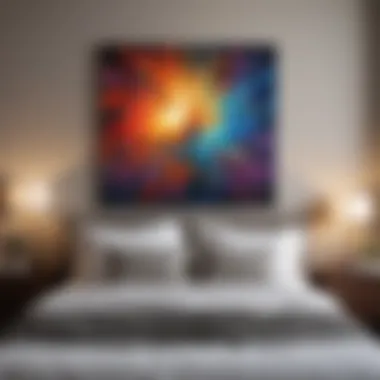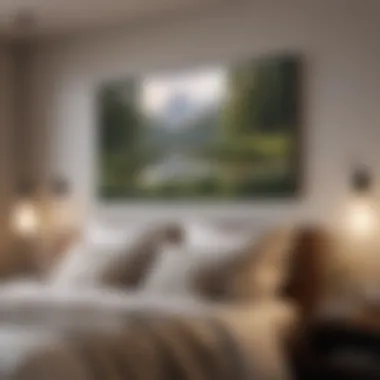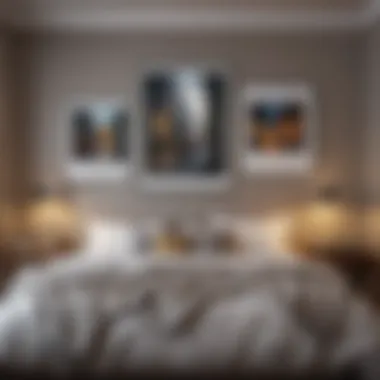Art Above Master Bed: A Guide to Perfect Selection


Intro
Selecting the right art to hang above the master bed can significantly influence the overall ambiance of a bedroom. It serves as both a focal point and a means of personal expression. This guide endeavors to provide homeowners and design enthusiasts with essential insights about art selection and positioning, ensuring the chosen pieces harmonize with the room's aesthetic. Understanding styles, themes, colors, and emotional resonance can transform a simple space into a sanctuary.
Art functions not merely as decoration, but as a reflection of the inhabitant's personality. Therefore, a careful selection process should be undertaken. One must consider various aspects such as scale and color. Each element plays a critical role in achieving a serene and inviting environment. This article will dissect these components in detail, offering practical advice and innovative ideas for the modern homeowner.
Design Inspiration
Creating an inviting bedroom relies on thoughtful design choices. Art can enhance this experience, grounding it in personal taste while contributing to the overall aesthetic.
Trending Styles and Themes
When considering art for the space above the master bed, various styles can be selected to reflect personal preferences. Some popular styles include:
- Abstract Art: Offers bold colors and shapes to evoke emotion.
- Nature Themes: Pieces depicting landscapes or botanicals can establish a calming atmosphere.
- Photography: Black-and-white photos add a timeless feel while color photography can invigorate the space.
- Minimalism: Clean lines and open spaces resonate with those who prefer simplicity.
Each style can showcase a unique narrative, thus influencing how one feels in the room.
Color Palettes and Combinations
Colors play a vital role in emotional response. When integrating art, consider the existing color scheme of the bedroom. Options can include:
- Monochromatic: Utilizing various shades of a single color can create a serene and sophisticated look.
- Contrasting Colors: A vibrant piece can serve as a standout element against soothing neutrals.
- Complementary Palettes: Harmony can be achieved by selecting colors opposite on the color wheel, enhancing visual dynamics.
Art must echo or highlight the color schemes of the room, creating cohesion and flow.
"The right artwork can elevate the entire mood of a room and influence how we feel when we step into it."
In the realm of interior design, it is essential to remember that the art selected must resonate with the personal taste of the homeowner. Making such choices should involve a reflective process, ensuring the art not only complements but also enriches the intimate setting of the master bedroom.
Understanding the Role of Art in Interior Design
Art serves as a powerful medium for self-expression and can significantly enhance the ambience of any space. When it comes to the master bedroom, the placement and selection of art can make or break the room's overall aesthetic. It offers homeowners an opportunity to personalize their interiors, making the area feel more like a sanctuary.
The Significance of Personal Expression
Personal expression through art is an essential aspect of interior design. The pieces you choose to hang above the bed can tell a story, reveal your interests, and reflect your personality. Art can range from abstract paintings, photographs, prints, or even personal creations. Each piece is a representation of individual tastes and preferences.
When selecting art, consider not just the visual appeal but also the emotional connection you have with the artwork. Ask yourself what the piece means to you. Does it invoke memories? Does it represent a pivotal moment in your life? This significance can transform a mere object into a cherished element of your bedroom, fostering a deeper emotional environment.
Transforming Spaces through Art
Art possesses a unique ability to transform spaces. A strategically placed artwork can draw attention, create focal points, and enhance the perception of space. A well-chosen piece can elevate the design theme of your bedroom, whether it be modern, traditional, minimalist, or bohemian.
For instance, large canvases can create a sense of grandeur, while a collection of smaller pieces can add a curated, personalized touch. Consider the mood you wish to evoke in your bedroom. Softer colors and soothing subjects can create a calming atmosphere, whereas vibrant and bold artworks might energize the space.
"Art is the most beautiful of all lies; it can turn the ordinary into extraordinary."
Thus, choosing the right art goes beyond mere decoration; it actively contributes to how you experience the space. It engages the senses and reinforces the intended purpose of your bedroom as a place for rest and relaxation.
Choosing the Right Artwork for Your Master Bedroom
Choosing the right artwork for your master bedroom is crucial for creating a tranquil and inviting space. This process involves understanding personal preferences, selecting colors that resonate with the overall decor, and ensuring that the chosen art complements the mood of the room. The artwork above the bed serves not just as decoration; it acts as a statement piece that can influence the entire atmosphere of the bedroom. In this section, we will explore the essential components of making informed choices for your bedroom art.


Identifying Your Style
Identifying your style is the first step in curating art for your master bedroom. Personal taste plays a major role in this phase. You may find that you prefer modern abstracts while your partner loves classical landscapes. Finding common ground is important. Consider creating a mood board or a collection of images that resonate with you. This can help clarify what styles truly speak to your aspirations for the space.
When thinking about styles, it helps to familiarize yourself with a few popular categories:
- Modern: Clean lines, bold colors, and simplicity are characteristic of modern art.
- Traditional: This often includes classic subjects like landscapes or portraits.
- Eclectic: Here, various styles mix together, resulting in a visually interesting array of pieces.
By understanding your preferred style, you can select art that reflects your identity and enhances the room's ambiance.
Considering the Color Palette
The color palette of your bedroom is another critical consideration when selecting artwork. The colors in your artwork should harmonize with the existing hues of your decor. This does not mean everything should match but rather should complement each other. Analyzing the wall color, furniture, bedding, and other elements will guide artwork selection.
Here are some tips to think about:
- Complementary colors: Choose art that utilizes colors found in your bedding or curtains to create a cohesive look.
- Accent colors: Consider using artwork to introduce a pop of color to an otherwise neutral space.
- Subdued tones: Soft, pastel colors can create a feeling of calm and tranquility, perfect for a bedroom.
Incorporating the right colors will elevate your space visually, creating a serene and balanced environment.
Exploring Themes and Motifs
Art can tell stories, embody ideas, and reflect themes that resonate deeply with the homeowner. When exploring themes and motifs, consider what feelings or memories you want to evoke. Will the artwork reflect tranquility, romance, or adventure? This clarity will inform the selection process.
Common themes you might consider include:
- Nature: Landscapes or botanical prints offer a sense of serenity.
- Abstract: Non-representational forms provide a focal point without specific meaning.
- Urban: Cityscapes bring a modern edge to the space.
Selecting appropriate themes allows for personal expression and invites a narrative into the bedroom decor. Consideration of these elements will ensure that the art not only beautifies the room but also connects with the viewer on a deeper level.
"Art enables us to find ourselves and lose ourselves at the same time." - Thomas Merton
By carefully selecting artwork that aligns with your style, palette, and themes, you will create a harmonious atmosphere in your master bedroom that invites relaxation and reflection.
Placement Considerations for Above the Bed
In the realm of interior design, the placement of art above the bed serves not merely as a decorative choice but also as a strategic decision that impacts the overall harmony and aesthetic of the master bedroom. When selecting artwork for this prominent location, several factors come into play that can enhance the room's atmosphere. Careful consideration of height, scale, and the interaction with surrounding furniture is essential to create a cohesive visual experience.
Optimal Height and Scale
Art above the bed should be placed at an optimal height that draws attention without overwhelming the space. A common guideline is to position the center of the artwork at eye level, which generally ranges from 57 to 60 inches from the floor. However, each room may require adjustments based on the size of the furniture below.
Consider the scale of the art in relation to the bed itself. Oversized pieces can make a bold statement, while smaller works may feel lost unless grouped thoughtfully. Large canvases or framed prints can provide a stunning focal point, while a series of smaller frames can create an intimate gallery wall effect. Always consider the proportions of both the bed and the room to ensure a balanced appearance.
Using the right scale not only enhances visual appeal but also promotes a psychological sense of comfort. An art piece that is too small may not carry enough visual weight, leading to a disjointed look, while one that is excessively large can dominate the space in an uninviting manner.
Creating Balance with Furniture
In any bedroom, the arrangement of furniture plays a critical role in the overall design and flow. When placing art above the bed, it's important to achieve balance with the elements already in the room. If the bed is accompanied by nightstands, lamps, or other furniture, the artwork should complement these pieces.
One way to do this is by ensuring that the width of the artwork is proportionate to the bed’s width. If the bed is a king-size, consider a large piece or a set of smaller pieces that, together, match the width of the bed. This can create a unified look. Furthermore, the art should also align in some form with the style of the furniture, whether that is modern, rustic, or something else entirely.
In addition to width, height matters too — the visual line created by the artwork should work harmoniously with the headboard and other decor. A taller or more elongated piece may need to be offset by the size of the headboard or adjacent furnishings to avoid them seeming disconnected.
"The key to effective placement is understanding how the art interacts with its environment; balance and proportion are your allies in achieving a pleasing aesthetic."


Ultimately, the aim is to create a visually cohesive arrangement that draws the eye in without causing chaos. By taking into account both the optimal height and scale alongside considerations of balance with existing furniture, the artwork above the bed can contribute significantly to a serene and inviting bedroom atmosphere.
Types of Art That Work Well Above a Bed
Selecting the right type of art to position above a master bed is pivotal in establishing the overall aesthetic of the bedroom. This space often serves as a personal retreat, where one seeks both comfort and inspiration. The artwork displayed can enhance the room's atmosphere and create a sense of harmony. Whether it’s framed prints, textiles, or mixed media art, each option offers distinct benefits and considerations.
Framed Prints vs. Canvases
Framed prints are a classic option for above the bed. They can complement various styles, from contemporary to traditional. The key advantage is versatility; prints come in numerous sizes and designs, allowing homeowners to craft a personalized gallery wall or a singular statement piece. Choosing the right frame can significantly impact the print's appearance, ensuring that it aligns with the room's decor.
On the other hand, canvases bring a different dimension to the space. They often have a texture that adds depth, and because canvases do not require framing, they tend to be less formal. This can work exceptionally well in relaxed, modern bedrooms. The choice between framed prints and canvases largely depends on your individual style and how you wish to evoke emotions in the space.
Textiles and Tapestries
Textiles such as tapestries can introduce warmth and character to the wall above your bed. Unlike traditional art pieces, textiles provide a soft, inviting feel. They can serve as a focal point while also adding color and texture. This is especially useful in minimalist settings, where a tapestry can be the single standout element.
When selecting textiles, consider the material and pattern. Natural fabrics often exude a sense of calm, while vibrant patterns can energize the space. Hanging textiles may require different installation methods compared to standard wall art. Ensure that you securely attach them to avoid any accidents while engaging with the space.
Wall Sculptures and Mixed Media
Wall sculptures and mixed media art pieces are often undervalued yet can be incredibly impactful. Sculptures introduce three-dimensionality to the space, striking a contrast with traditional flat art. This can invite curiosity and lead to deeper conversations. Mixed media works, combining different materials and techniques, often resonate with those who appreciate eclectic atmospheres.
In considering wall sculptures, look for shapes and forms that echo the lines in your existing furniture or decorations. This can create a cohesive environment. Be mindful, however, of the scale; oversized pieces can dominate a small wall while smaller sculptures may lose their effect in larger spaces.
"Art above the bed is not just decor but an emotional anchor, creating a personal connection to the room."
When selecting art for above the bed, homeowners should be aware of how each type contributes to the overall ambiance. Each option presents its unique attributes, offering various ways to express individual style while maintaining an inviting atmosphere.
The Emotional Impact of Art in the Bedroom
Art is not just visually appealing; it can shape one’s emotional landscape. The emotional impact of art in the bedroom is profound, as it plays a role in how space is perceived and experienced. This area of the home is personal, often serving as a sanctuary for relaxation and reflection. Thus, selecting the right pieces of art can enhance mood and contribute positively to the overall atmosphere.
There are several dimensions to consider when thinking about art's emotional influence. One significant factor is the ability of art to evoke feelings of calm. Pieces that resonate with tranquility can create a serene environment. Moreover, art has a unique capacity to reflect personal narratives and memories. This connection to one's life can enhance emotional ties to the space, making it feel more like home.
Using Art to Create Calm and Serenity
Incorporating art that embodies calmness is essential for creating a peaceful retreat. Gentle imagery, soft colors, and flowing forms can encourage relaxation. Subjects like landscapes, abstract representations of water, or gentle pastels can elevate the feeling of serenity in the bedroom.
A few approaches include:
- Nature Scenes: Art that depicts nature, such as trees, mountains, or oceans, often brings a sense of tranquility.
- Soothing Colors: Blues and greens are known for their calming effects. They can promote feelings of peace and openness.
- Minimalist Designs: Sometimes, less is more. A minimalist approach to art can reduce visual clutter and promote a calm environment.
When selecting pieces, consider how these artworks fit into the overall theme of your bedroom. The goal is to foster a sense of relaxation and dissolve daily stressors.
"Art should comfort the disturbed and disturb the comfortable."
—Cesar A. Cruz
Eliciting Emotions Through Imagery
The imagery found in art can induce a variety of emotional responses. Different subjects and colors can tell a story or convey specific feelings. For instance, portraits may evoke empathy or nostalgia, while abstract pieces can stir a sense of curiosity or reflection. It is crucial to choose images that not only speak to the individual but also resonate with the atmosphere you want to cultivate in your bedroom.
Consider the following aspects when selecting art:
- Narrative Power: Select pieces that reflect personal stories. This can promote a deeper connection to the artwork and elevate one's living experience.
- Emotional Resonance: Think about how the artwork makes you feel. A piece that brings up happy memories can create a warm environment, while others may offer a more introspective atmosphere.
- Symbolism and Themes: Explore objects or themes that are significant to you. Artworks that resonate personally can generate stronger emotional ties.


Ultimately, the artwork above the bed serves a dual purpose: it decorates the room and influences the emotional tone of the space. By paying attention to these aspects, homeowners can successfully curate a collection that maintains the desired ambiance.
Incorporating Personal Narratives into Artistic Choices
When it comes to art, personal narratives hold a special significance, especially in spaces like the master bedroom. The integration of storytelling in artistic choices can create an environment that feels warm and inviting. Each piece can reflect meaningful experiences, memories, or aspirations that resonate with the individual or family living in the space.
Displaying Family Heirlooms and Memories
Family heirlooms offer an exceptional way to weave personal history into the fabric of your living space. These items often carry stories that go beyond mere aesthetics, embodying the spirit and tradition of past generations. From framed photographs to handcrafted items, displaying these heirlooms can bring richness to the decor.
In choosing where to place these meaningful pieces, consider the following points:
- Select a centerpiece: Choose a focal point above the bed, such as a larger piece that captures attention and draws the eye. A well-placed heirloom can foster a sense of connection and harmony in the room.
- Pair with contemporary elements: Merging old with new can produce dynamic visuals. For instance, matching a vintage frame with a modern canvas can add depth to the space while telling a more comprehensive story.
- Create a gallery wall: Arranging different heirlooms together can form a cohesive gallery. This method not only highlights personal narratives but also evokes deeper emotional responses.
The stories attached to family heirlooms can serve as conversation starters. They can elicit fond memories and spark discussions about legacy and heritage. To maintain focus on these personal narratives, ensure that the art complements the overall design and color scheme of the room.
In summary, incorporating personal narratives through art can transform the master bedroom into a sanctuary filled with shared memories and sentiments. When art reflects genuine experiences, it infuses the space with life, making it distinctly yours.
A Look at Art Trends in Interior Spaces
Understanding current art trends is essential for homeowners and design enthusiasts who wish to create an inviting atmosphere. The art placed above the master bed can serve as a focal point, enhancing the overall design scheme of the bedroom. Being aware of popular movements and emerging styles allows you to make informed choices, reflecting both personal taste and broader aesthetic values.
Popular Art Movements and Their Influence
Art movements often mirror social, political, and technological changes. Themes that were once central can shift with time, influencing current practices in interior design. Here are some notable art movements that shape contemporary choices:
- Minimalism: This movement emphasizes simplicity and functionality. Art in this style often features clean lines and a limited color palette. Choosing minimalist art for above the bed can promote a sense of calm in the master bedroom.
- Abstract Expressionism: This reflects emotional intensity and spontaneity. Abstract pieces can add energy to a space, making the room feel vibrant and alive.
- Modernism: Focused on innovative and forward-thinking designs, modernism often incorporates unconventional materials and forms. Including modern art above your bed can create a striking contrast against traditional furnishings.
Patients of these movements offer valuable insights into designing a personal sanctuary. For example, modernism might appeal to those seeking to instill a contemporary vibe, while minimalism aligns with those who value simplicity.
"Art is not what you see, but what you make others see." – Edgar Degas
Emerging Artists and New Perspectives
In recent years, the rise of new artists has introduced fresh perspectives that challenge traditional norms. These artists often draw on cultural diversity and engage with current issues. Incorporating their work into your bedroom can establish a personal connection and ensure that your décor remains relevant. Finding local artists or platforms that support newcomers can help broaden your collection. Consider the following:
- Cultural Significance: Many new artists reflect their backgrounds in their work. Engaging with such art can introduce enriching narratives into your bedroom, making it not just a space for rest but also for reflection.
- Sustainability: Emerging artists may often prioritize environmentally friendly practices. Supporting these creators aligns with a broader commitment to sustainable living and can lead to unique pieces that resonate with ecological consciousness.
- Technological Innovation: With digital technology influencing art creation, find pieces that utilize new mediums. This could mean exploring digital prints or interactive installations that engage viewers on different levels.
Maintaining Your Art Collection
Maintaining an art collection, especially in a space as significant as above the master bed, is crucial for preserving its integrity and enhancing the overall aesthetic of the room. Art is not merely decoration; it embodies personal expression and emotional resonance. A well-maintained collection continues to provide joy and inspiration. Neglecting this responsibility can lead to deteriorating conditions that detract from the artwork's beauty and meaning.
Proper Care and Preservation Techniques
The preservation of art involves several key practices that ensure its longevity and visual appeal. First, consider the environment where the art is displayed. Factors such as light exposure, humidity, and temperature can significantly affect artworks’ condition. It is often advisable to avoid placing pieces in direct sunlight, as this can cause colors to fade over time.
Here are some effective care techniques:
- Regular Cleaning: Gently dust the artwork with a soft, lint-free cloth to remove particles that may scratch the surface. For more valuable pieces, consult with a professional conservator for specialized cleaning methods.
- Proper Framing: Use acid-free materials when framing to prevent deterioration. Glass or acrylic coatings can protect against dust and damage.
- Control the Environment: Maintain humidity levels at around 40-50% and temperatures between 65-75°F to prevent warping and mold growth.
- Avoid Contact: Do not touch the surface of the artwork directly, as oils from fingers can lead to deterioration.
By focusing on these techniques, homeowners can significantly extend the life of their art collection and maintain its value.
When to Rotate or Replace Artwork
Rotating or replacing artwork in the bedroom can be an effective way to refresh the atmosphere and maintain a dynamic aesthetic. Regularly updating the collection ensures that the space does not become stale or monotonous. This practice can also invoke new emotional responses to the space, keeping the bedroom a sanctuary of comfort and style.
When considering rotation, factors to think about include:
- Seasonal Changes: Different times of year may call for different color palettes and themes. Light, airy pieces might be preferable in summer, while richer, more saturated colors could enhance a winter bedroom.
- Your Personal Journey: As life evolves, so do personal tastes and experiences. Artwork that resonated with you years ago may not have the same significance today.
- Physical Condition: If an artwork shows signs of wear or is damaged, it may be better to replace it with a new piece.
Ultimately, the decision to rotate or replace should align with one's evolving preferences and the emotional impact desired within the space. By pondering these considerations thoughtfully, the art collection can continue to reflect personal stories and bring joy.



